Preprint
Article
Transforming Irrigated Agriculture in Semi-Arid and Dry Subhumid Mediterranean Conditions: A Case of Protected Cucumber Cultivation
Altmetrics
Downloads
44
Views
27
Comments
0
A peer-reviewed article of this preprint also exists.
This version is not peer-reviewed
Submitted:
26 October 2024
Posted:
28 October 2024
You are already at the latest version
Alerts
Abstract
Pressure from population growth and climate change stress the limited water resources in the Mediterranean region and threaten food security and social stability. Enhancing food production requires the transformation of irrigation systems and enhancement of local capacity for sustainable water and soil management in irrigated agriculture. The aim of this work is the conversion of traditional irrigation practices, by introducing the practice of optimal irrigation scheduling based on local ET estimation and soil moisture monitoring, and the use of continuous feeding by fertigation to enhance both water and nutrient use efficiency. For this, two trials were established between August and November 2023 in two different pedoclimatic zones (Serein and Sultan Yacoub) of the inner Bekaa plain of Lebanon, characterized by semi-arid and dry subhumid conditions and different soil types. Protected cucumber was tested to compare the prevailing traditional farmer’s practice of empirical nutrient and water management using closed tanks with the advanced methods of water accounting and soil moisture monitoring using differential injector that allow more homogeneous application of nutritive solutions and simple tensiometers. Results showed a significantly higher amount of water applied by the farmers to the protected cucumber with a potential for average saving of 105 mm by improved practices. Water input was accompanied by higher amplitude of variation of soil moisture in the farmer’s practice before and after the irrigation cycle revealing potential stress to plant performance caused by higher water depletion followed by over irrigation. With more than 20% increase in cucumber yield by the transformed practices, a general trend in both locations was observed in the fertilization approach and amounts resulting in lower nutrient recovery in the farmer’s plots. The science-based practices of water and nutrient management showed higher application and agronomic water use efficiency of full fertigation, exceeding 60%, associated with double and triple higher nitrogen use efficiency, compared to those results obtained by the traditional water and fertilizer application methods. The monitored factors contribute to severe economic and environmental consequences from nutrient buildup in the soil-groundwater system in the Mediterranean region.
Keywords:
Subject: Environmental and Earth Sciences - Water Science and Technology
1. Introduction
Drought and water scarcity exert immense pressure on natural resources, compromising crop production and food security (FAO, 2022). Moreover, the combination of population growth and climate change is placing additional stress on the already limited water resources, particularly in the Mediterranean region. This is affecting livelihoods, food security, economic development, and even social stability (Abdelmoneim et al., Darwish Faour2024). Agricultural lands are integral components of natural landscapes, each with specific agro-ecosystems. To achieve food security and meet Sustainable Development Goals (SDGs), the intensification of sustainable practices shall comply with the requirements of low environmental impact and prevention of agricultural land expansion at the expense of natural landscapes (Edreira et al., 2021). Equally critical is curbing urban expansion into arable lands. Prioritizing this, prevents detrimental land use changes that harm biodiversity and disrupt sustainable ecosystems (Darwish et al., 2009; Amanullah et al., 2017).
To enhance food production and meet growing demands, advanced genetic engineering has focused on optimizing shoot-root design and improving beneficial water use in crops (Hall and Richards, 2013). However, inadequate irrigation system performance can hinder water use efficiency (khadra & Sagardoy, 2019) and impact food production (Fufa, 2023). Traditional irrigation system practices, coupled with a lack of soil moisture monitoring, lead to suboptimal irrigation scheduling, nitrate leaching, and reduced water use efficiency (Darwish et al., 2011). Beyond environmental consequences, excessive water pumping from wells contributes to groundwater depletion, limiting water productivity and economic benefits (Yang et al., 2022).
To mitigate these challenges, research gaps on sustainable land management must be closed to compensate the low percentage of research and papers addressing land degradation and evidence based sustainable land management in the region (Haregeweyn et al., 2023). In this regard, crop diversification should be considered and cash crops in adapted rotations introduced (Yang et al., 2021). Sequencing shallow and deep-rooted crops optimizes water use across different soil layers (Yang et al., 2017). Additionally, incorporating crop residues before planting the next crop enhances yield and achieves complementarity in nitrogen and water use (Zhang et al., 2022).
Crop switching and more efficient water and energy use increased the benefits of irrigated agriculture with reduced footprint of water and fertilizer use and gas emission (Xie et al., 2023). Crop productivity in irrigated agriculture is affected by prevailing soil and climatic conditions, cultivars and farming practices. To address yield gaps, it is essential to enhance irrigation and agricultural practices (Agnolucci et al., 2020). Numerous factors - biotic, abiotic and socio-economic- affect crop productivity and the environmental impact of agriculture. Consequently, integrating agriculture with other ecosystems and land uses, as well as and adapting to climate change becomes imperative (El Chami and El Moujabber, 2024).
Previous studies conducted on the coastal Lebanese area demonstrated the benefits of fertigation for protected cucumber cultivation. Fertigation significantly improved nitrogen and water use efficiency while minimizing risks of salt accumulation and leaching of soluble chemicals into the groundwater (Atallah et al., 2000). The farmers’ practice in the Bekaa Plain of Lebanon consists of applying fertilizers in intermittently every second irrigation event that contribute to the leaching of nitrates (Darwish et al., 2006) and even less mobile phosphorous (Guo et al., 2023) within the topsoil and beyond the root zone. Farmers apply empirical estimation of crop water demands and apply excess water without appropriate water accounting strategy. Our work is trying to capitalize, and establish a solid link between research and development, by upgrading the modalities of nutrient and water input in continuous feeding to modernize agriculture in Lebanon. The novelty of this approach is the technology and evidence based estimation of crop water needs and the prevention of salinity rise in the root zone when applying water and nutrients with every irrigation event. Compared to the farmer’s practice of double dose of fertilizers, followed by the leaching of salts and nutrients in fresh water application the next irrigation cycle, the advanced approach of SEALACOM prevented water and salinity stress to protected cucumber. An optimized nutrient input and adapted irrigation schedule can sustain plant health and provide higher productivity with reduced energy and fertilizer cost and limited environmental hazards (Chen et al., 2023).
As protected greenhouses expanded into the Bekaa plain - an elevated inland ranging between 800 and 1100 m asl – bridging the gap between research and development of remote rural areas becomes crucial through the introduction of more efficient irrigation technology.
Analyzing local community performance, particularly farmers’ fertilization, and irrigation practices, and energy use, is necessary to ensure the proper transformation and sustainability of protected agriculture at higher elevations. Consequently, this work aims to analyze yield gaps, enhance fertilization and irrigation practices and promote capacity building among local farmers by establishing demonstration sites (DSs) in two pedoclimatic zones within the Bekaa Plain of Lebanon.
2. Materials and Methods
To achieve the project’s objectives related to sustainable water use in agriculture with a low energy and environmental footprint, two DSs were selected. These sites represent two pedoclimatic zones within the Bekaa plain of Lebanon, covering a total area of 86251.8 ha, with 45.8% representing agricultural land use.
2.1. Geographic Location
The first area is located in Central Bekaa, specifically in Serein village, and the second in Sultan Yacoub village, West Bekaa. Serein exhibits a level plain, while Sultan Yacoub features undulating foot slopes. Both areas are surrounded from east and west by the sloping and steep rocky lands of Mount Lebanon and Anti-Lebanon mountain chain (Figure 1). DS1, located at Serein (Casa of Zahle), stands at an elevation of 950m asl, while DS2, situated in Sultan Yacoub within the Casa of West Bekaa, is 850m asl.
2.2. Climatic Conditions
The mean annual climatic data were obtained from the climatic stations of Tal-Amara (LARI, 2024). DS1 falls within the semi-arid climatic zone, receiving 566 mm of annual precipitation, primarily between November and March (Figure 2). The rest of the year remains dry, with mean high and low annual temperature reaching 25.6° and 8.5°C respectively. DS2 belongs to the dry-subhumid climatic zone, with annual rainfall of 700 mm and mean high and low annual temperature reaching 24.56° and 10.85° C.
2.3. Soil Properties
Regarding soil characteristics, both DSs predominantly consist of Cambisols, Regosols and Luvisols with additional presence of Vertisols, Calcisols, Leptosols, Arenosols and Andosols (Figure 3). DS1’s soil is classified as deep Eutric Regosols, characterized by neutral pH and non-saline properties. It exhibits a clay texture with negligible CaCO3 content (Table 1). The soil has an average low organic matter content, is poor in total nitrogen, but enriched in phosphorous and shows moderately high availability of potassium.
The soil cover of DS2 was classified as Eutric Cambisols. The soil texture is clay, with low organic matter content and a neutral-weakly basic pH (Table 1). DS2’s soil is non-saline, poor in nitrogen, enriched with available phosphorous, and highly enriched with potassium. The targeted zone (DS1 and DS2) represents a relatively large area of 120 ha, making it suitable for nontraditional, intensive, protected farming in elevated semi-arid Mediterranean conditions (Figure 4) that do not require heating in winter. Notably Lebanon has experienced significant greenhouse expansion, with a total area of 1560 ha dedicated to greenhouses (CNRS, 2023).
The selected demonstration sites represent valuable agro-climatic zones with diverse and multiple irrigated cropping systems, characteristics for the dry Mediterranean region, and provide insights into yield gaps and sustainable land management practices and the intricate interactions of water, energy, and food systems, targeted by the SEALACOM project.
2.4. Experimental Design
Field experiments focused on the protected cucumber cultivation in both locations, considering pedo-climatic variability and different farmers’ practices. In Serein, three plastic walk-in houses (each measuring 8 X 41.5 m, with a total area of 996 m2) served as the control treatment group (Figure 5). The Project managed three similar, nested, experimental greenhouses.
In Sultan Yacoub, 4 greenhouses (each measuring 9 x 34 meters (Figure 6), with a total area of 612 square meters for the two control houses and similar area for the other two experimental houses) were part of the experiment. In this way, we had two treatments (experimental and control greenhouses), replicated 5 times in 2 locations. In both DSs, farmers managed the control greenhouses as usual, applying fertigation with locally available complex, soluble, fertilizers using traditional closed tanks.
2.5. Modality of Water and Fertilizer Application
Once the irrigation volumes are supplied to the soil, the infiltration and redistribution processes occur and contribute to regulating the water exchange within the soils, plants, and atmospheric system. Thus, the adopted irrigation management strategy, which defines the frequency and interval of the interventions, does nothing but steadily interfere with the soil–water interactions, modifying the available soil water and the water and salt fate (Dragonetti and Khadra, 2023).
Farmers independently managed the types, amounts and timing of nutrient and water applications, following traditional irrigation practices with intermittent nutrient delivery ha was continuously monitored by the project. In contrast, the SEALACOM project adopted advanced practices that were observed by the farmers.
The project estimated the required irrigation water based on ETo (reference evapotranspiration) calculations specific to the given site, adjusted for ETa (actual evapotranspiration) within the greenhouse (ETo multiplied by a factor of 0.65), and factored in the crop coefficient (Kc). Instead of using the expensive and highly precise dosatron injectors, the project employed a feasible venturi system, securing homogeneous and proportional, continuous water and nutrient, application. To ensure proper functioning of the venturi, it is necessary to keep a constant pressure in the system (2 Mbars) with differential pressure at the entry and output. This approach differed from the farmers’ intermittent fertigation using the traditional closed tank (Figure 7a; Figure 7b).
2.5. Monitoring of Soil Moisture
The SEALACOM team monitored soil moisture using tensiometers to regulate water application and irrigation scheduling. Tensiometers were placed at depths of 20 cm and 40 cm in both the farmers’ cucumber test sites and the SEALACOM experimental sites. These devices measured soil head potential (Figure 8), i.e., the negative soil water potential through a ceramic and porous cup, reflecting soil water content. Measurements were taken at the onset of irrigation and 24 hours after each irrigation event, allowing time for gravity water to infiltrate. Additionally, water meters were used to precisely control water application and measure the cumulative volume of water applied in each greenhouse (Figure 9).
2.6. Land Preparation and Cultivation Cycle
The farmers in Serein followed specific practices to prepare their Land for cucumber cultivation: Soil plowing at 30 cm depth, was followed by surface soil smoothing and irrigation network setting. A total of 100 kg of organic compost was added to each greenhouse, as basic fertilizer equivalent to 3000 kg/ha. Prior to seedling transplant, soil was irrigated (8320 L/greenhouse of 332 m2, equivalent to 25 m3/1000 m2) and sterilized with fungicide and insecticide.
Cucumber seedlings were transplanted on August 18, 2023, and supported with peat to prevent fungal diseases. The cucumbers were planted at 5 cm depth in double rows, with 45 cm between single rows and 90 cm between double rows. The distance between seedlings was 40 cm (Figure 10). Each greenhouse contained 1,040 seedlings, equating to 31325 seedlings/ha. After transplanting, each greenhouse was irrigated with 4160 L (12.5 m3/ha). To support the new seedlings, irrigation was carried out 10 minutes every morning and evening, using 693 L/greenhouse (2.0 m3/ha) each time.
Land preparation at Sultan Yaacoub involved plowing to a depth of 30 cm, chiseling, and applying basic fertilizers. Farmers in Sultan Yacoub typically use 50 Kg of Vermicompost and 50 Kg of complex fertilizers (15:15:15). To test the potential of using only organic compost, the project agreed with the farmer to apply only 50 Kg of Vermicompost to the SEALACOM managed experimental greenhouse N1, while SEALACOM greenhouse N2 received the usual combination of 50 kg vermicompost and 50 kg complex fertilizers, received by the control house.
Cucumbers in Sultan Yacoub were planted on August 19, 2023, one day later than in Serein. The distance between two nested irrigation lines was 45 cm, and the distance between seedlings was 40 cm (Figure 11). The planting depth was 5 cm, and each greenhouse contained 1020 seedlings.
2.7. Estimation of Crop Water and Nutrient Demands
Nutrient and water requirements of protected crop in the farmer’s practice relied on farmer’s skills and knowledge. They were recorded as done by the farmer without any intervention rom the experimental team. Water and nutrient demands of protected cucumber in the SEALACOM Plots relied on previous data received from earlier experiments, using isotope technique, showing the dynamic of crop consumption (Atallah et al., 2000).
2.8. Statistical Analysis
Statistical analysis was done using the descriptive statistics on Excel 2016. The means were calculated followed by the confidence intervals, considering a 95% significance level. The comparison of the means could be done through the confidence ranges obtained as [mean ± confidence interval]. If two confidence ranges overlapped then the means were not considered different (p<0.05).
3. Results and Discussion
3.1. Management of Irrigation of Protected Cucumber
While famers irrigated the crop and determined irrigation duration based on their own skills without measuring soil water status, the SEALACOM project followed a comprehensive approach. The project team based irrigation events and amounts with reference to climatic conditions, crop growth, production, and other field measurements (Figure 12).
The water applied by the farmers throughout the cucumber season in both locations was significantly higher than the amount applied by the SEALACOM project (Table 2). This trend was also observed during the short production cycle of protected cucumbers at both DSs (Figure 13).
The over-irrigation by farmers was evident from the soil head potential levels recorded before and 24 hours after irrigation.
Figure 14 and Figure 15 show higher amplitude of variation in farmer’s practice, which can cause stress before irrigation and water stagnation after irrigation, potentially leading to fungal diseases. The observed low variation in soil moisture in SEALACOM approach suggests the provision of better soil moisture conditions for improved crop performance with lower depletion level prior to next irrigation event.
These experimental results indicate a high potential for water savings in protected cucumber cultivation in the Central and West Bekaa Plain and the whole country with simple capacity building and the adoption of simple and cost effective IT devices to monitor soil moisture and estimate the right water amount and regulate the irrigation schedule (Table 2).
3.2. Fertilization Practices of Protected Cucumber
The fertilization policy followed by the farmers is not based on soil sampling and analysis to consider the available soil pool and nutrient balance. Additionally, farmers rarely conduct water analysis to check for nutrients like nitrogen derived from nitrates. From primary sources, during the cucumber fall season of 2023, the farmer in Serein applied a total of 27.5 kg N Deca-1, 11.4 kg P2O5 Deca-1 and 6 kg K2O Deca-1 (Table 3). Famers in Sultan Yacoub applied a comparable amount of nutrients, except for phosphorous, using different types and ratios of fertilizers.
3.3. Yield of Protected Cucumber in Traditional and Advanced Practices
The average yield of protected cucumbers obtained from fertigation in Serein during the late fall 2023 production season, using the continuous feeding system (2911.6 kg Deca-1), exceeded the yield obtained by the farmer’s traditional practice (2379.5 Kg Deca-1) by 22.4% (Figure 16).
Equally important to notice the same trends in cumber yield obtained in Sultan Yaoub with the advantage of continuous feeding of cucumber based on science based methods of estimation of crop water and nutrient demands (Figure 17). The exception observed in the lower yield of treatment S-compost can be probably explained by the poor natural soil fertility background and low nitrogen presence in the soils of the arid Mediterranean climate. The combination of compost with basic mineral fertilizer application is a justified pre-sowing practice in the region.
The improved practice produced significantly higher yield as compared to the farmers practice within the same location (Serein) in the Bekaa valley (Table 4). In the absence of an overlapping within the confidence range (Table 4), the superior yield within the improved treatment could be validated. Within the other location (Sultan Yaacoub), yield results could not be validated due to different background fertilization practice based on the testing of soil response to sole application of vermicompost in one of the two SEALACOM greenhouses that reduced the number of replicates.
Results proved the low natural fertility of the Lebanese soils caused by the low organic carbon content and showed the necessity to increase the soil organic carbon sequestration in the soils of the semi-arid regions to improve their productivity with minimal reliance on mineral fertilizers (Darwish et al., 2018a).
3.4. Water Use Efficiency of Protected Cucumber in Traditional and Advanced Practices
Comparing the application and agronomic water use efficiency between full fertigation and traditional water and fertilizer application during the late fall protected cucumber season showed clear advantage of modern practices in water and nutrient application to meet the challenges of food security (Table 5).
Land suitability for large-scale irrigation and adapted cropping patterns was also successfully tested in even more arid conditions using multiscale climate and soil conditions, sustainable water use, topography and improved land management practices (Aldababseh et al., 2018). The sustainability of agricultural production in the country is in direct connection with the environmental performance to reduce water, nutrient, energy and labor input and address the needs of environmentally friendly practices (Skaf et al., 2019).
Comparing the efficiency of water use in the SEALACOM project with the farmers’ practice showed the potential to achieve total cucumber harvests of 2911.6 and 2379.5 kg deca-1. Our results demonstrated the advantage of combined use of water and nutrients, in continuous feeding mode by full fertigation, in dry Mediterranean area. Indeed, the obtained results show that the efficiency of total applied water by SEALACOM project surpassed the farmer’s practice by 1.82 times in Serein and 1.67 times in Sultan Yacoub (Table 4). Using the SEALACOM adopted methods allowed to achieve higher agronomic water use efficiency in Serein and Sultan Yacoub equivalent to 2.83 and 1.65 times, respectively. Our findings support the climate proofing Lebanon’s Development Plan (UNDP, 2021) and National Water Sector Strategy Update (MoEW, 2020) to promote agricultural resilience to climate change, mitigate GHG, and improve national and local adaptation, notably, in the integrated management of the irrigation and water sectors.
The same statistical approach was applied to water productivity of both sites and treatments (Table 6). The confidence ranges in Serein (15.30-1.01= 14.41) and in Sultan Yacoub (16.71-2.58=14.85), showed no overlapping with those obtained in farmer’s practice to the confidence interval in Serein (8.41+ 1.08 =9.36) and Sultan Yacoub (9.96+0.67)=10.45. The same trends was observed for the treatment of improved fertigation versus traditional fertigation, where the values were 14.50 and 10.14, respectively. The absence of overlapping indicates significant difference between the replicates and treatments.
3.5. Nitrogen Use Efficiency of Protected Cucumber in Traditional and Advanced Practices
Nutrient use efficiency for applied nitrogen in protected cucumber was calculated for two different fertilization and watering practices: those experimented by SEALACOM and those implemented by the farmers in the Central and West Bekaa plain (Table 7).
The results show that advanced nitrogen management considering the soil and water pools and crop demands, allowed to reach 3.32 and 2.30 times higher nitrogen use efficiency in both locations. Fertigation of protected cucumber in the coastal area using the isotope 15N showed advantageous nitrogen uptake by the crop, which reduced risks of nitrogen buildup in the soil and limited nitrate leaching into the groundwater (Atallah et al., 2000).
3.6. Effect of Fertigation Practices on Soil Quality
While both fertigation methods caused slight buildup of salts in the soil, the continuous fertigation slightly increased Soil EC value of the surface layer from 0.49 to 0.64 in Serein while ECe remained within the control level in Sultan Yacoub (Table 8).
Lower values of soil salinity rise in intermittent fertigation were explained by the potential leaching of salts towards the groundwater (Papadopolous, 1988). The accumulation of phosphorus and potassium in the soil after the experiment was comparable in the two nutrient application modalities with some accumulation of P2O5 in Sultan Yacoub. Results show that continuous fertigation has no direct negative ecological impact, especially if the soil pool is considered in the following cropping season, it might represent economic advantages in water saving and higher water productivity.
Earlier studies conducted in the semi-arid Lebanese region showed salinity development and yield reduction of greenhouse cucumber in traditional fertilizer and water application (Rubeiz and Maluf, 1989). A comparable cucumber yield was possible to obtain only under the use of plastic mulch in late summer protected cucumber (Rubeiz et al., 1991).
More advanced results were possible to obtain under protected vegetables on the coastal areas even with the use of slightly saline water in irrigation due to appropriate management of fertigation and irrigation schedule based on the monitoring of soil moisture (Darwish et al., 2018b). Water scarcity in inland Bekaa area and intensive agriculture have been associated with excess pumping from groundwater causing the depletion of groundwater table level (Shaban, 2020).
A higher water use efficiency was achieve in the improved practices due to controlled water use in irrigation according to crop water demands. The onsite estimation of ET0 and appropriate irrigation schedule, related to soil moisture monitoring, and fertigation following the continuous feeding lead to higher nutrient recovery and cucumber yield. Over irrigation observed by the farmer, detected from permanently humid subsoil during the production stage (Figure 15), coupled with intermittent fertilizer application, could have contributed to leaching of soluble forms of nitrogen and decreased crop yield. The approach followed by the SEALACOM project has both economic and environmental consequences mainstreaming the sustainable farming in drylands. For this reason, disseminating good irrigation practices with reliance on combined climatic data, crop cycle and soil moisture to achieve economic yields with less water and fertilizer inputs are important measures to transform traditional practices in the Bekaa into economically sustainable and environmentally sound exercises.
Our results demonstrated the possibility to increase yield of protected cucumber with controlled application of fertilizers and water associated with better water accounting and higher water productivity. Extrapolating to the national and regional levels, a significant breakthrough in water saving can be achieved that supports sustainable agriculture and meets the challenges of SDGs.
Despite the small scale and short duration of the experiments, representing a potential source of error, the results provide a room for the deep analysis of current state of water and fertilizer use in emerging agricultural production of semi-arid and dry subhumid areas and allow for the prospection of feasible road map for improved practices.
4. Conclusion
Compared to the empirical water and fertilizer application methods commonly used in Lebanon and similar semi-arid and dry subhumid regions, the advanced practices followed by the SEALACOM project have proven to be more efficient. By adequately considering soil and crop conditions, monitoring nutrient and water balance, climatic conditions, measured ET values, and controlling soil moisture for suitable irrigation schedules, significant advantages in water, fertilizer, and energy savings were achieved. Full fertigation of late fall protected cucumber with continuous feeding using simple modern injectors resulted in significantly higher yields and better water and fertilizer use efficiency. Under the conditions of climate change and water scarcity, achieving water saving of 93 to 122 mm per single, short, fall protected cucumber season is significant for meeting food security challenges and the objectives of the SDGs. Additionally, the SEALAOM project applied 2 to 5 times less nitrogen and phosphorous. Water and nutrient savings positively impacted application and agronomic water use efficiency, which were 2 to 4 times higher with the SEALACOM approach compared to the traditional farmer practices. Water and fertilizer savings, combined with better cucumber yields and higher productivity per unit of applied water and nutrients, result in higher returns and reduced GHG emissions related to the fertilizer industry and water pumping using fossil energy that prevail in the region. Obtained results are evidence based tools to upgrade policy and close the research gaps to serve decision making at different water allocation and water use levels.
Efforts should focus on capacity building to improve current practices and disseminate effective water and nutrient management at both district and country levels. Upgrading operational infrastructure and introducing IT tools for water and nutrient management, as well as soil and crop monitoring, are crucial for enhancing the technical basis of intensive agriculture. These advancements will help meet the challenges of the SDGs and address socio-economic constraints to achieve sustainable rural livelihoods. This research provides a foundation for deriving practical guidelines and recommendations for farmers, optimizing intensive agriculture to enhance productivity and sustainability. By examining socio-economic benefits, we can offer valuable insights into improving agricultural practices. Looking ahead, it is essential to project the potential expansion of intensive agriculture in response to climate change over the next decade. With anticipated increases in temperature and decreases in rainfall, adaptive strategies focusing on resilient crop varieties, efficient water management, and innovative farming techniques will be vital. By proactively addressing these challenges, we can support sustainable agricultural growth, ensure food security, and enhance the overall socio-economic well-being of the region. However, it is recommended to follow the impact of long term application of continuous feeding on soil biome and soil health.
Institutional Review Board Statement
Not applicable.
Informed Consent Statement
Not applicable.
Data Availability Statement
Not applicable
Acknowledgments
This paper is part of the SEALACOM project, funded by the Italian Cooperation, managed by the Mediterranean Agronomic Institute of Bari and executed and supported by the National Council for Scientific Research, Lebanon. The team thanks Dr Therese Atalla for her support and advises during the compilation of this paper.
Conflicts of Interest
The authors declare no conflict of interest.
References
- Abdelmoneim, A.A., Khadra, R., Elkamouh, A., Derardja, B., and Dragonetti, G. 2024. Towards Affordable Precision Irrigation: An Experimental Comparison of Weather-Based and Soil Water Potential-Based Irrigation Using Low-Cost IoT-Tensiometers on Drip Irrigated Lettuce. Sustainability, 16, 306. [CrossRef]
- Agnolucci, P., Rapti, C., Alexander, P. De Lipsis,V., Holland, R.A. Eigenbrod, F., and Ekins, P. 2020. Impacts of rising temperatures and farm management practices on global yields of 18 crops. Nat Food 1, 562–571. [CrossRef]
- Aldababseh, A., Temimi, M., Maghelal, P., Branch, O., and Wulfmeyer, V. 2018. Multi-Criteria Evaluation of Irrigated Agriculture Suitability to Achieve Food Security in an Arid Environment. Sustainability, 10 (3), 803. [CrossRef]
- Amanullah, Jr. Talal Darwish, Gunay Erpul, Ranier Horn, Nsalambi Nkongolo, Brajendra Parmar, Gary Pierzynski, Peter De Ruiter, and Miguel Taboada 2017. Threats to soils: global trends and perspectives. A Contribution from the Intergovernmental Technical Panel on Soils, Global Soil Partnership Food and Agriculture Organization of the United Nation. GLOBAL LAND OUTLOOK WORKING PAPER Editors: Gary Pierzynski and Brajendra. Secretariat: Lucrezia Caon and Ronald Vargas. UNCCD. PP 27.
- Atallah, T., Darwish, T., and Ward, R. 2000. La sérriculture de la côte nord du Liban: entre tradition et intensification. Cahiers d’Etudes et de Recherches Francophones-Agricultures. V.9 (2): 135-140.
- Chen, Sh., Liu, W., Morel, J., Parsons, D., and Du, T. 2023. Improving yield, quality, and environmental co-benefits through optimized irrigation and nitrogen management of hybrid maize in Northwest China. Agricultural Water Management, 290, 108577. [CrossRef]
- CNRS, 2023. Land cover /use map of Lebanon. http://rsensing.cnrs.edu.lb/geonetwork/srv/eng/search#fast=index&from=1&to=50.
- Darwish, T., Faour, G., and Khawlie. M. 2004. Assessing soil degradation by landuse-cover change in coastal Lebanon. Lebanese Science Journal (5), 1: 45-59.
- Darwish, T., Atallah, T., Hajhasan, S., and Haidar, A. 2006. Nitrogen and water use efficiency of fertigated processing potato. Agricultural Water Management 85: 95-104. [CrossRef]
- Darwish, T., Atallah, T., Francis, R., Saab, C., Jomaa, I., Shaaban, A., Sakka, H., and Zdruli, P. 2011. Observations on soil and groundwater contamination with nitrate, a case study from Lebanon-East Mediterranean. Agricultural Water Management, 99, 1: 74-84. [CrossRef]
- Darwish, T., Atallah, T., & Fadel, A. 2018a. Challenges of soil carbon sequestration in the NENA region. Soil, 4 (3), 225-235. [CrossRef]
- Darwish, T., Fadel, A., Atallah, T., Jomaa, I., and Baydoun, S. 2018b. Challenges and Opportunities for Crop Production Under Dry and Saline Environments in ARASIA. Chapter 6. Lebanon, pp. 47-65 by Joint FAO/IAEA Division of Nuclear Techniques in Food and Agriculture and Asia and The Pacific Section. IAEA TECDOC No. 1841. (ISBN:978-92-0-101918-9): 136 pp.
- Dragonetti, G., and Khadra, R. 2023. Assessing Soil Dynamics and Improving Long-Standing Irrigation Management with Treated Wastewater: A Case Study on Citrus Trees in Palestine. Sustainability, 15, 13518. [CrossRef]
- Edreira, R.J.I., Andrade, J.F., Cassman, K.G., van Ittersum, M.K., van Loon, M.P., and Grassini, P. 2021. Spatial frameworks for robust estimation of yield gaps. Nat Food 2:773–779. [CrossRef]
- El Chami, D., and El Moujabber, M. 2024. Sustainable Agriculture and Climate Resilience. Sustainability, 16, 113. [CrossRef]
- FAO. 2022. The State of the World’s Land and Water Resources for Food and Agriculture – Systems at breaking point. Main report. Rome. [CrossRef]
- Guo, Y., Wang, Z., and Li, J. 2023. Coupling effects of phosphate fertilizer type and drip fertigation strategy on soil nutrient distribution, maize yield and nutrient uptake. Agricultural Water Management, 290, 108602. [CrossRef]
- Hall, A.J., and Richards, R.A. 2013. Prognosis for genetic improvement of yield potential and water-limited yield of major grain crops. Field Crops Research, 143:18-33. [CrossRef]
- Haregeweyn, N., Tsunekawa, A., Tsubo, M., Fenta, A.A., Ebabu, K., Vanmaercke, M., Borrelli, P., Panagos, P., Berihun, M.L., Langendoen, E.J., Nigussie, Z., Setargie, T.A., Maurice, B.N., Minichil, T., Elias, A., Sun, J., and Poesen, P. 2023. Progress and challenges in sustainable land management initiatives: A global review, Science of The Total Environment, 858, 3, 160027. [CrossRef]
- Khadra, R., and Sagardoy, J.A. 2019. Irrigation Governance Challenges in the Mediterranean Region: Learning from Experiences and Promoting Sustainable Performance; Springer International Publishing: New York City, NY, USA.
- LARI, 2024. Lebanese Agricultural research Institute. Climatic Information. Department of irrigation and climatology.
- MoEW, 2020. National Water Sector Strategy Update-2020. https://faolex.fao.org/docs/pdf/leb211915EVolI.pdf.
- Papadopoulos, I. 1988. Nitrogen fertilization of trickle irrigated potato. Fert. Res. 16: 157-167. [CrossRef]
- Rubeiz, I. G., and Maluf, S. 1989. Effect of intensively cropping greenhouses in semiarid regions on soil salinity and nitrogen fertilizer requirements of cucumber. Journal of Plant Nutrition, 12(12), 1467–1472. [CrossRef]
- Rubeiz, I. G., Naja, Z. U., and Nimah, M. N. 1991. Enhancing Late and Early Yield of Greenhouse Cucumber with Plastic Mulches. Biological Agriculture & Horticulture, 8(1), 67–70. [CrossRef]
- Shaban, A. 2020. Water Resources of Lebanon. Springer Science Publisher, ISBN 978-3-030-48716-4. 229 pp.
- Skaf, L., Buonocore, E., Dumontet, S., Capone, R., and Franzese, P.P. 2019. Food security and sustainable agriculture in Lebanon: An environmental accounting framework. Journal of Cleaner Production, 209, 1025-1032. [CrossRef]
- UNDP, 2021. Climate-Proofing Lebanon’s Development Plans. Beirut, Lebanon. https://www.undp.org/lebanon/publications/climate-proofing-lebanons-development-plans.
- Yang, X.L., Steenhuis, T.S., Davis, K.F., van der Werf, W., Ritsema, C.J., Pacenka, S., Zhang, F.S., Siddique, K.H., and Du, T.S. 2021. Diversified crop rotations enhance groundwater and economic sustainability of food production. Food Energy Secur. 10, e311. [CrossRef]
- Xie, W., Zhu, A., Ali, T., Zhang, Z., Chen, X., Wu, F., Huang, J., and Davis K.F. 2023. Crop switching can enhance environmental sustainability and farmer incomes in China. Nature, 616: 300–305. [CrossRef]
- Yang, X.L., Chen Y.Q., Steenhuis T.S., Pacenka, S., Gao, W.S, Ma, L., Zhang, M., and Sui, P. 2017. Mitigating Groundwater Depletion in North China Plain with Cropping System that Alternate Deep and Shallow Rooted Crops. Front. Plant Sci. 8:980. [CrossRef]
- Yang, X., Wang, G., Chen, Y., Sui, P., Pacenka, S., Steenhuis, T.S., and Siddique, K.H.M. 2022. Reduced groundwater use and increased grain production by optimized irrigation scheduling in winter wheat–summer maize double cropping system-A 16-year field study in North China Plain. Field Crops Research, 275, 108364. [CrossRef]
- Zhang, L., Wang, X., Li, Y., Zhao, J., Yang, Y., Zang, H., and Zeng, Z. 2022. Peanut residue incorporation benefits crop yield, nitrogen yield, and water use efficiency of summer peanut – winter wheat systems. Field Crops Research, 279, 108463. [CrossRef]
Figure 1.
Topographic map of the SEALACOM Demo Sites showing the elevation range derived from DEM.
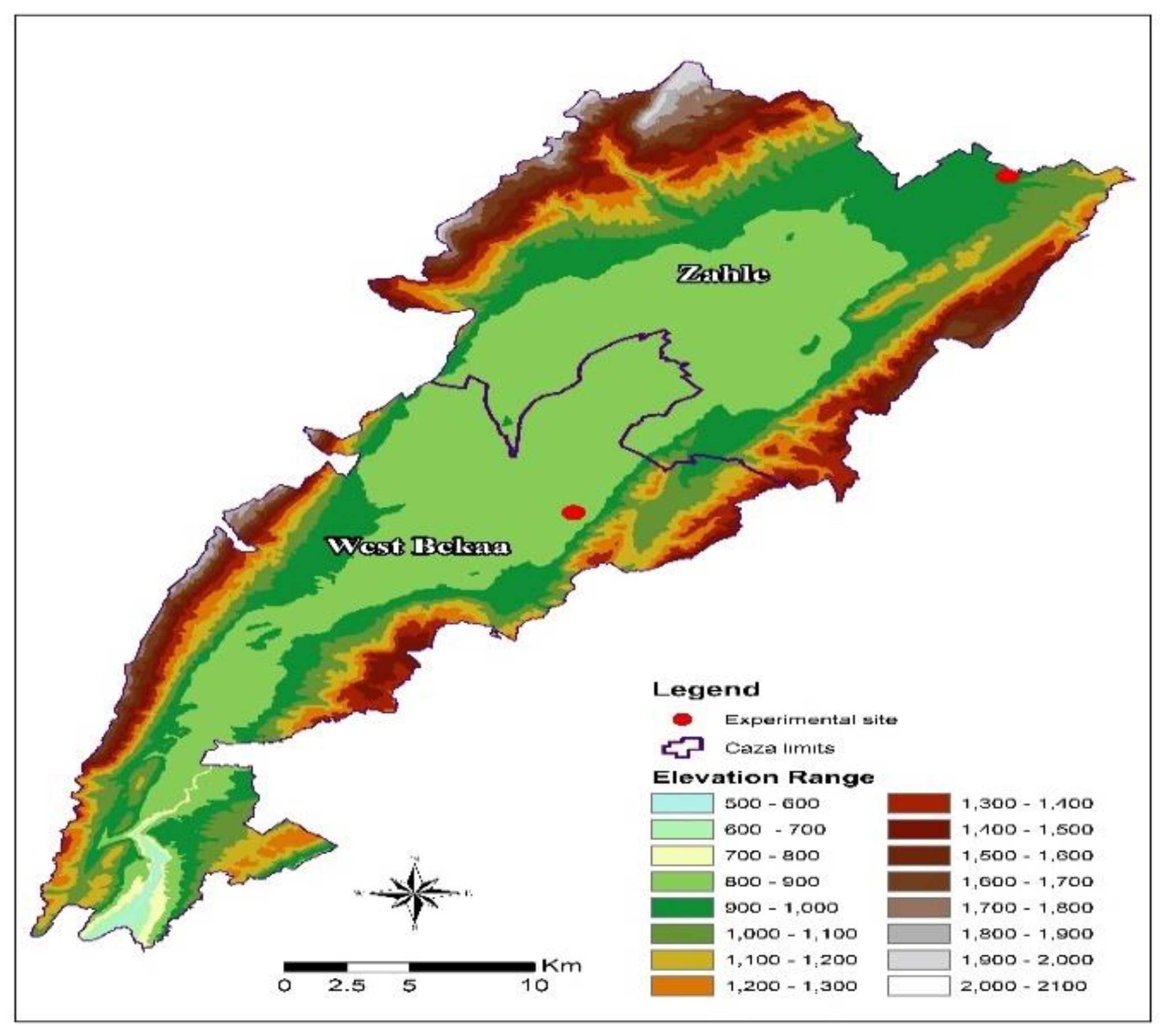
Figure 2.
Rainfall map of the SEALACOM Demo Sitess showing the 100-precipitation interval.
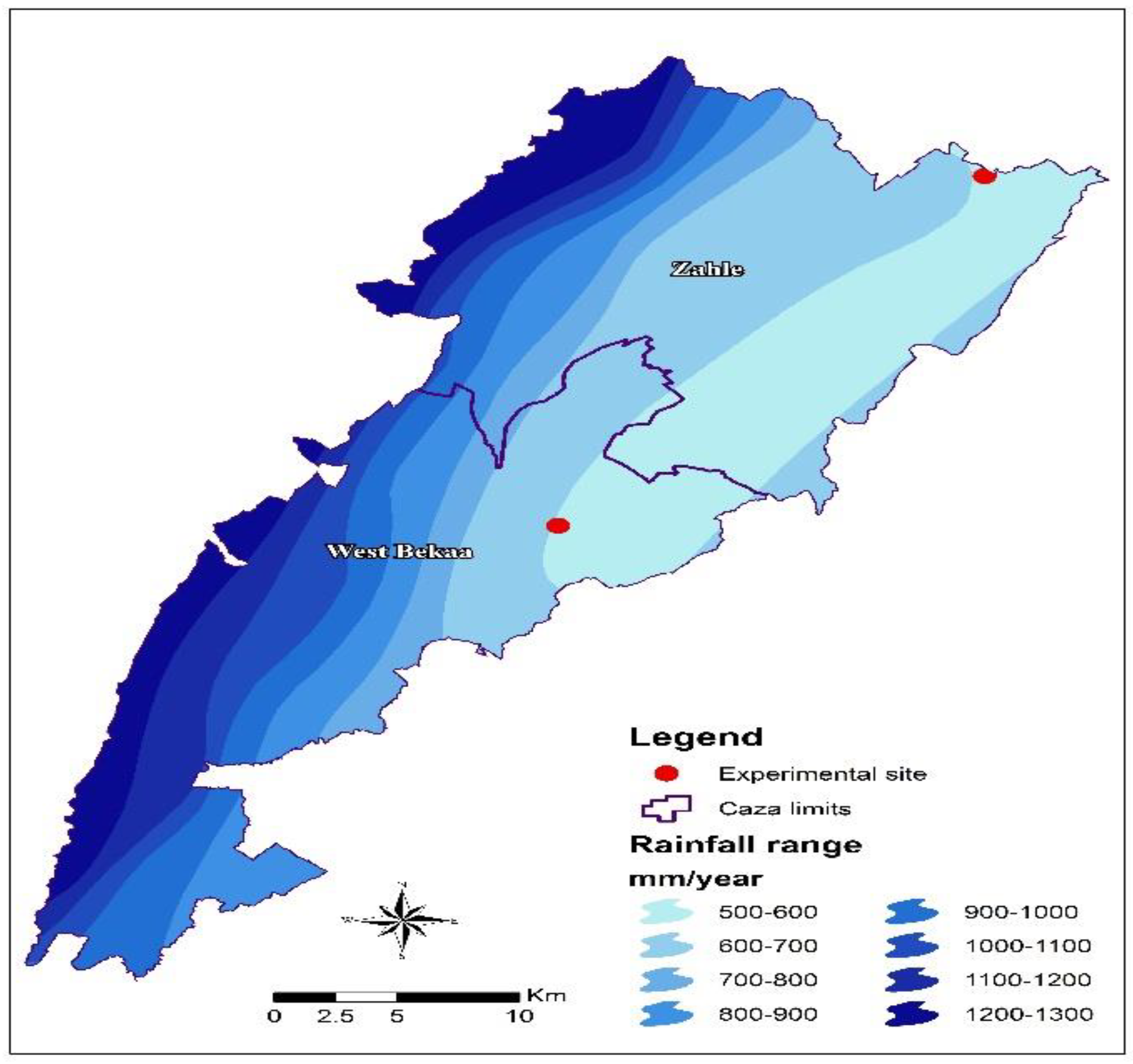
Figure 3.
Soil map of the SEALACOM area of study (Source: Darwish et al., 2006).
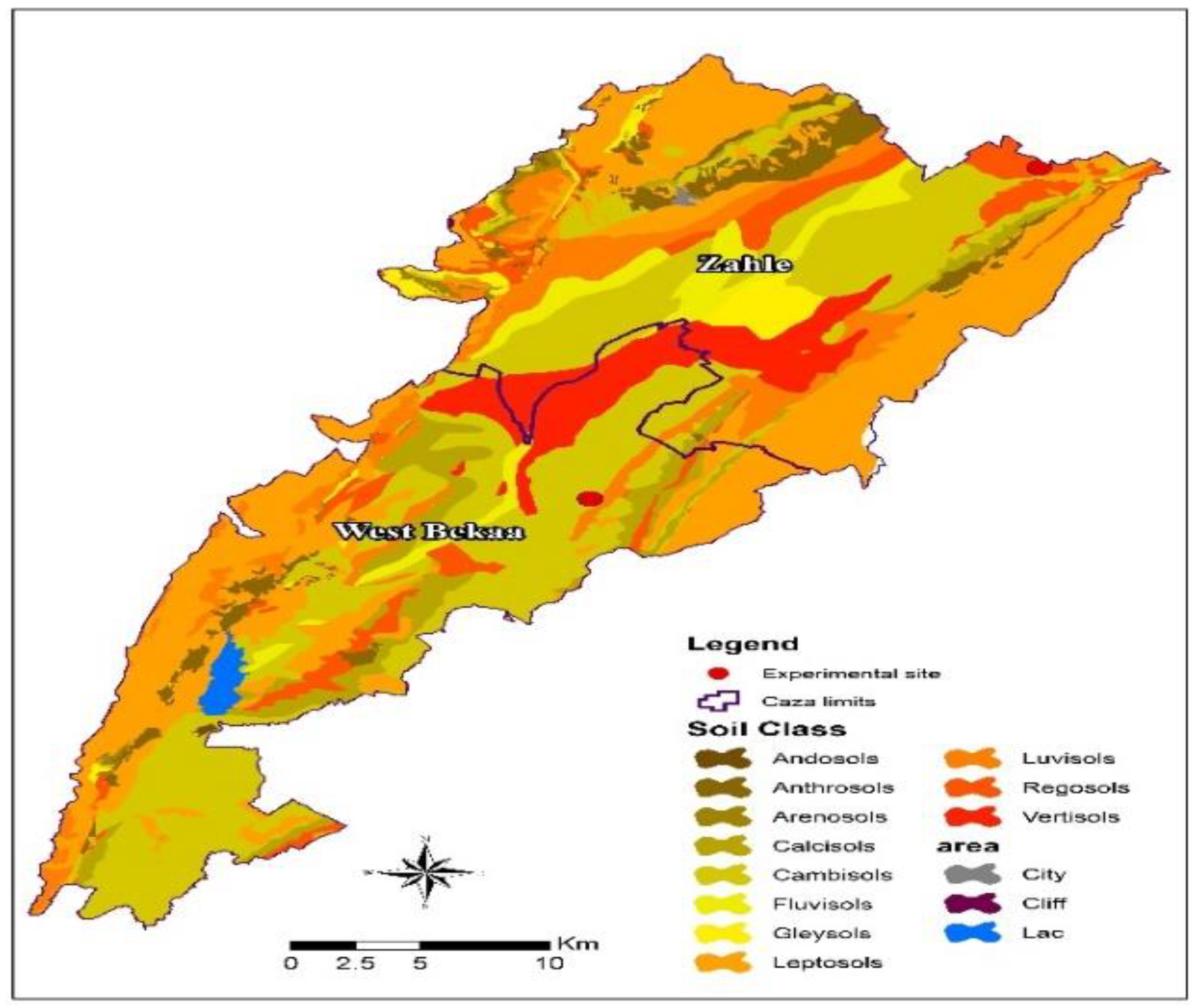
Figure 4.
Development of protected agriculture in Central and West Bekaa (Source: CNRS, 2023).
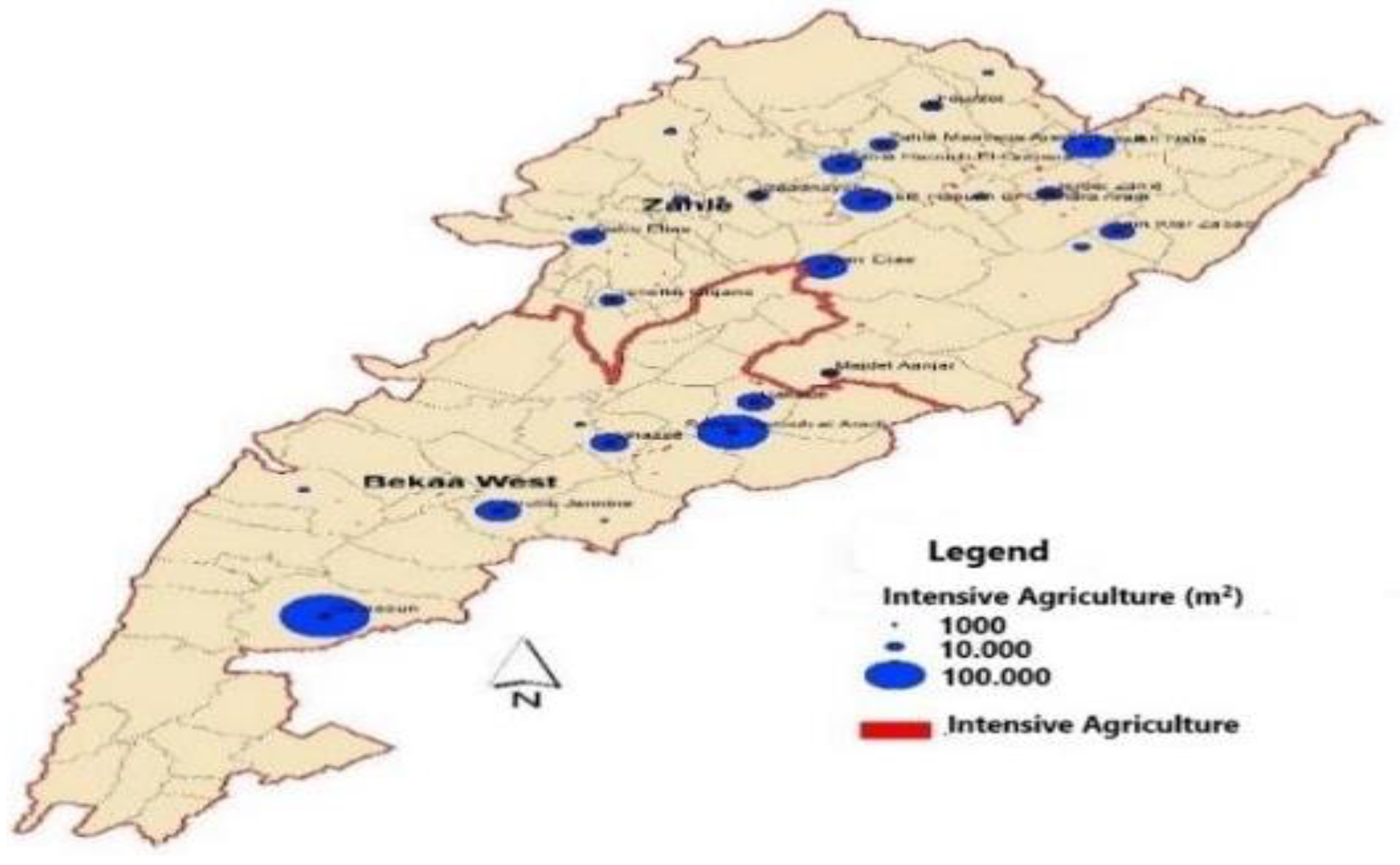
Figure 5.
Serein Experimental Site Coordinates 33° 52' 35" & 36° 02' 57".
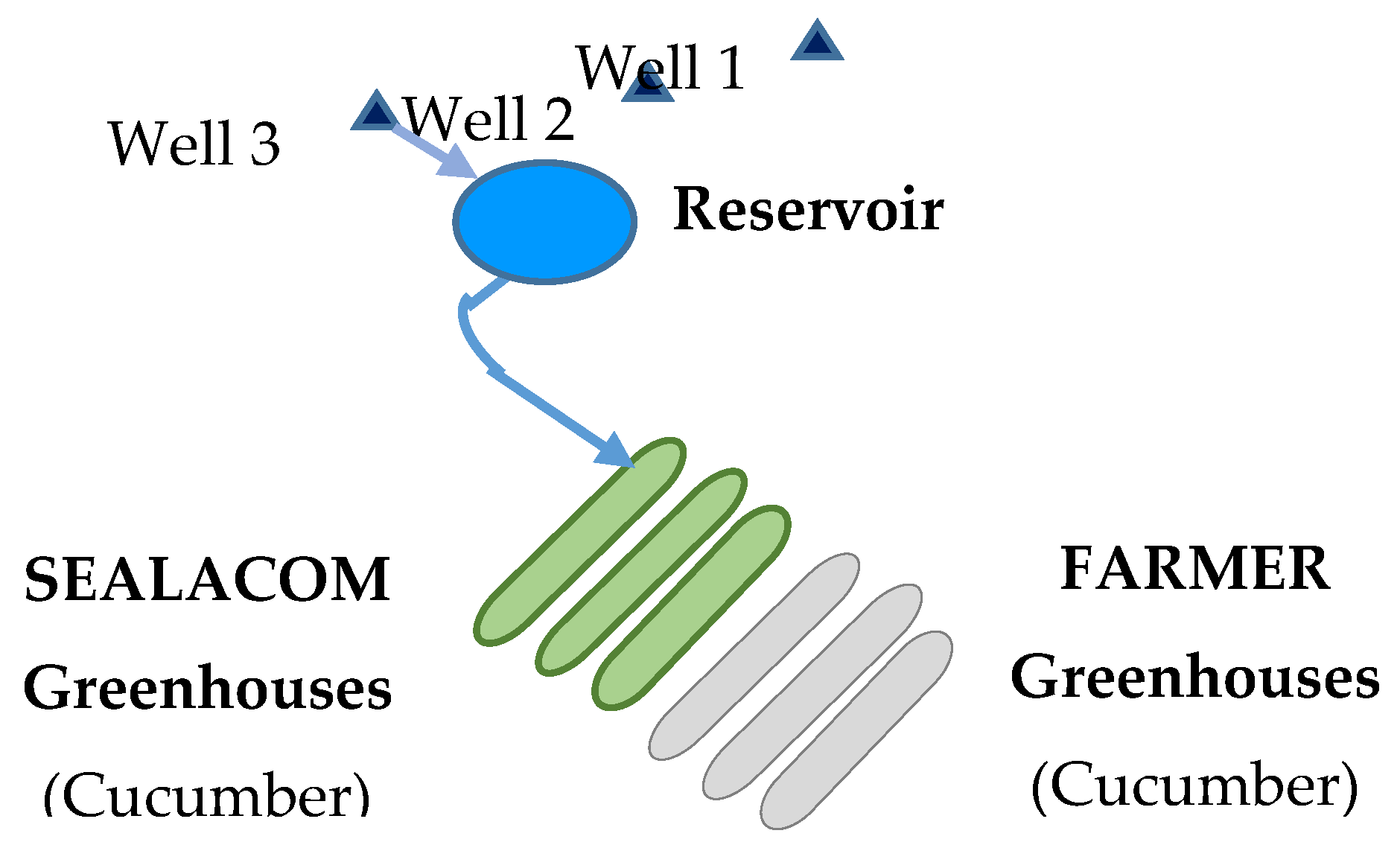
Figure 6.
Sultan Yaqoub Experimental Site Coordinates 33° 40' 20" & 35° 51' 41".
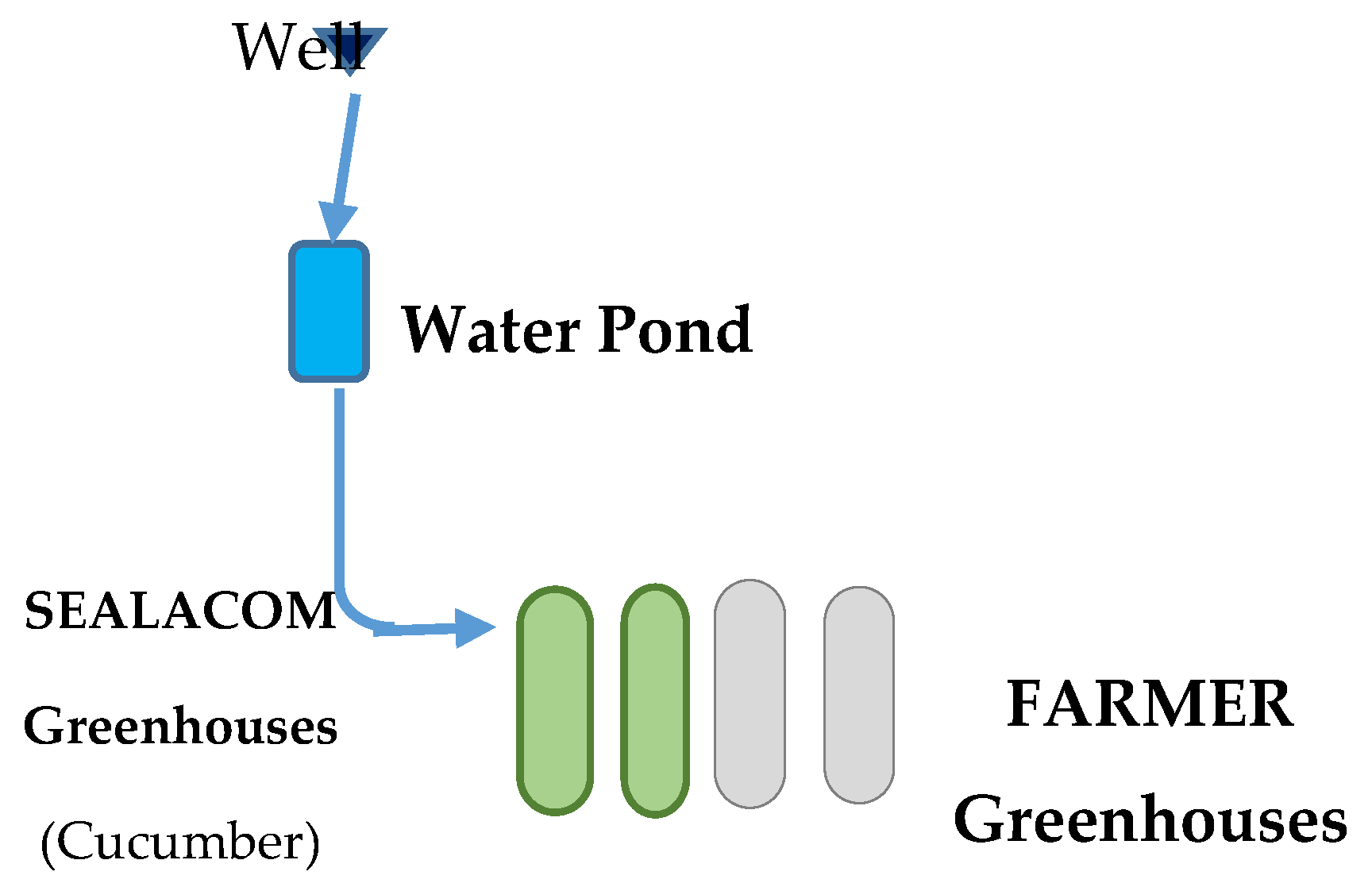
Figure 7a.
Venturi System for full fertigation mode maintains homogeneous nutrient application.
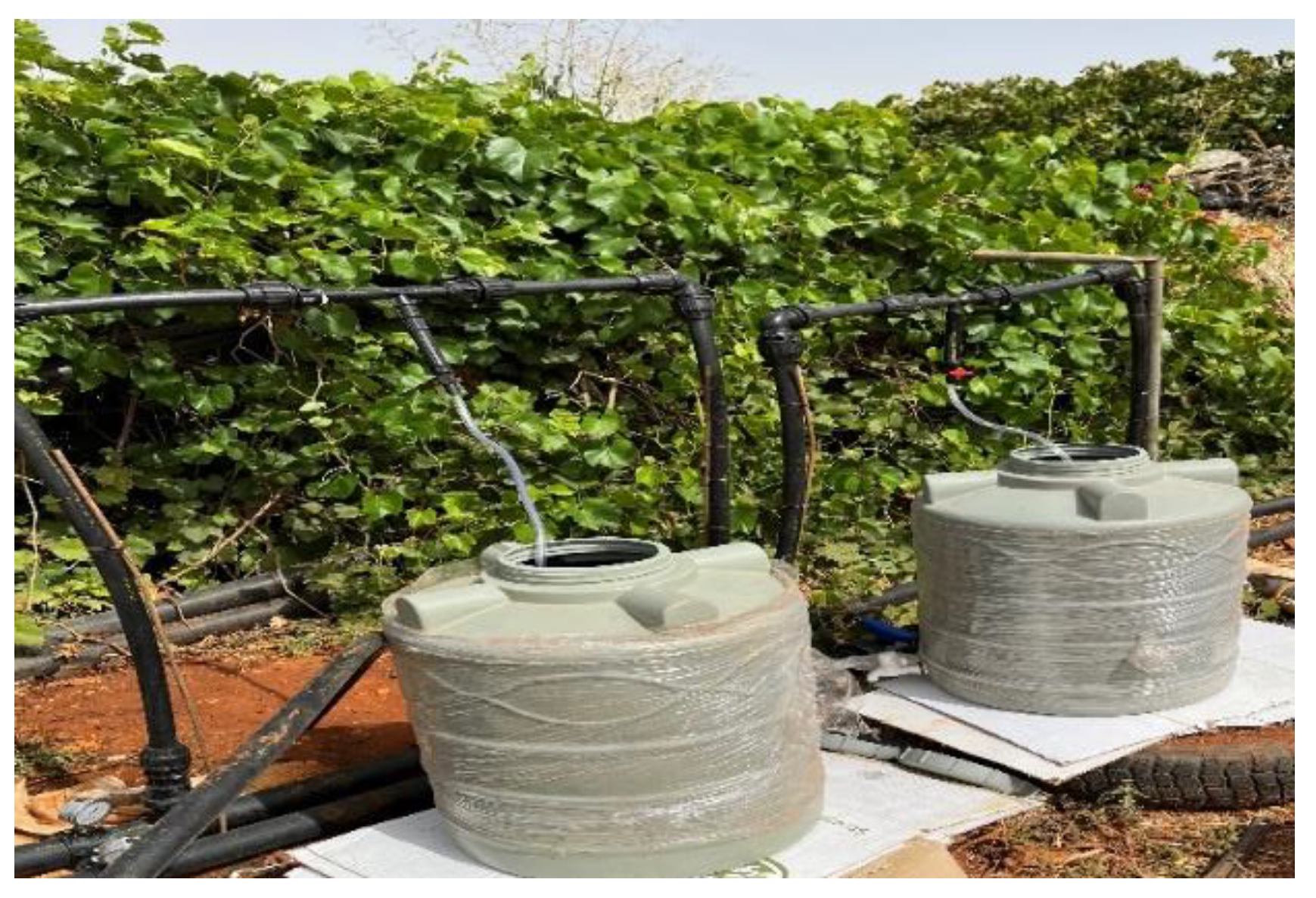
Figure 7b.
Closed tanks do not secure homogeneous nutrient application in time and spacec.
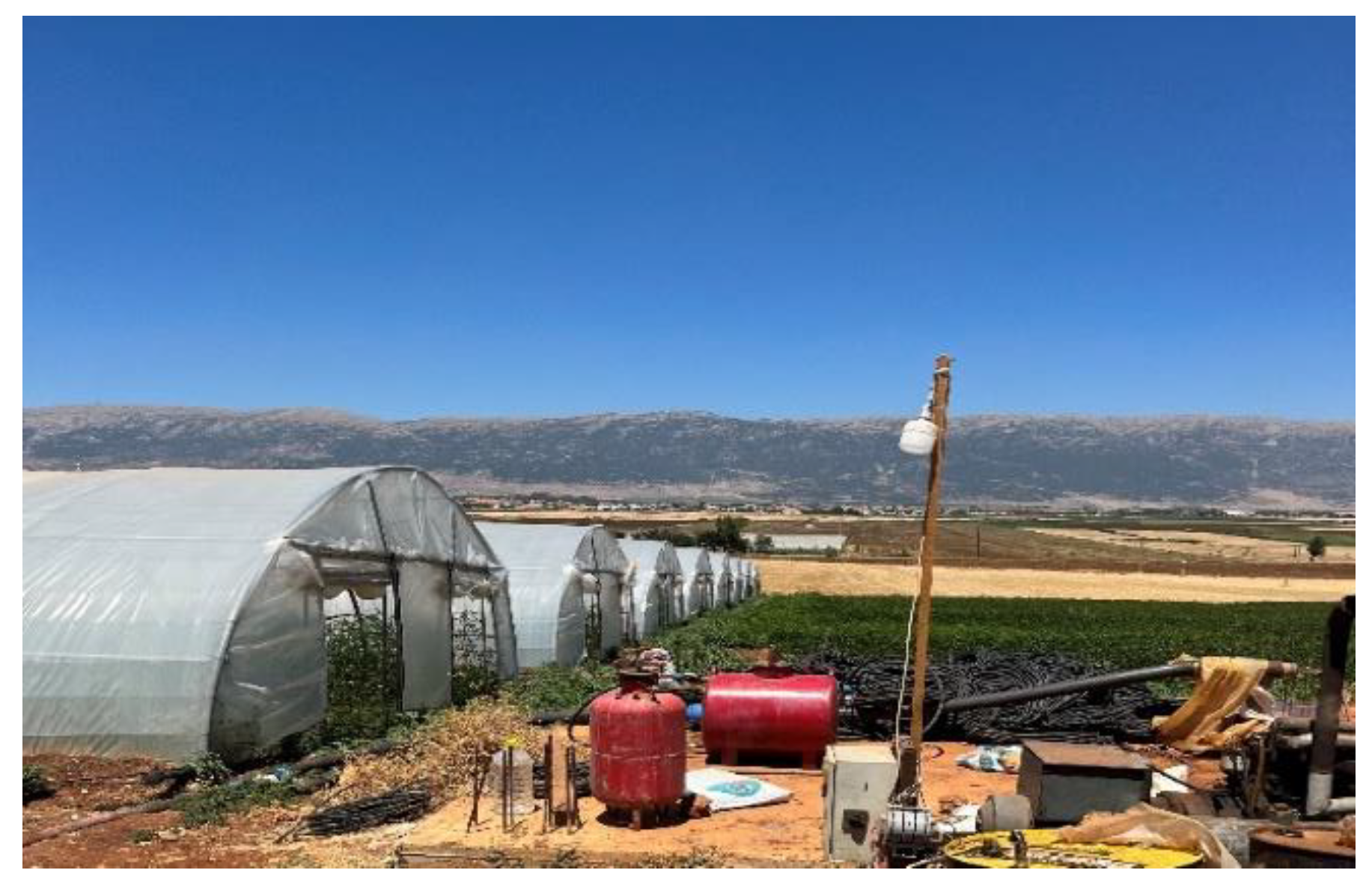
Figure 8.
Tensiometer to measure soil head potential (soil moisture) and schedule the onset of irrigation.
Figure 8.
Tensiometer to measure soil head potential (soil moisture) and schedule the onset of irrigation.
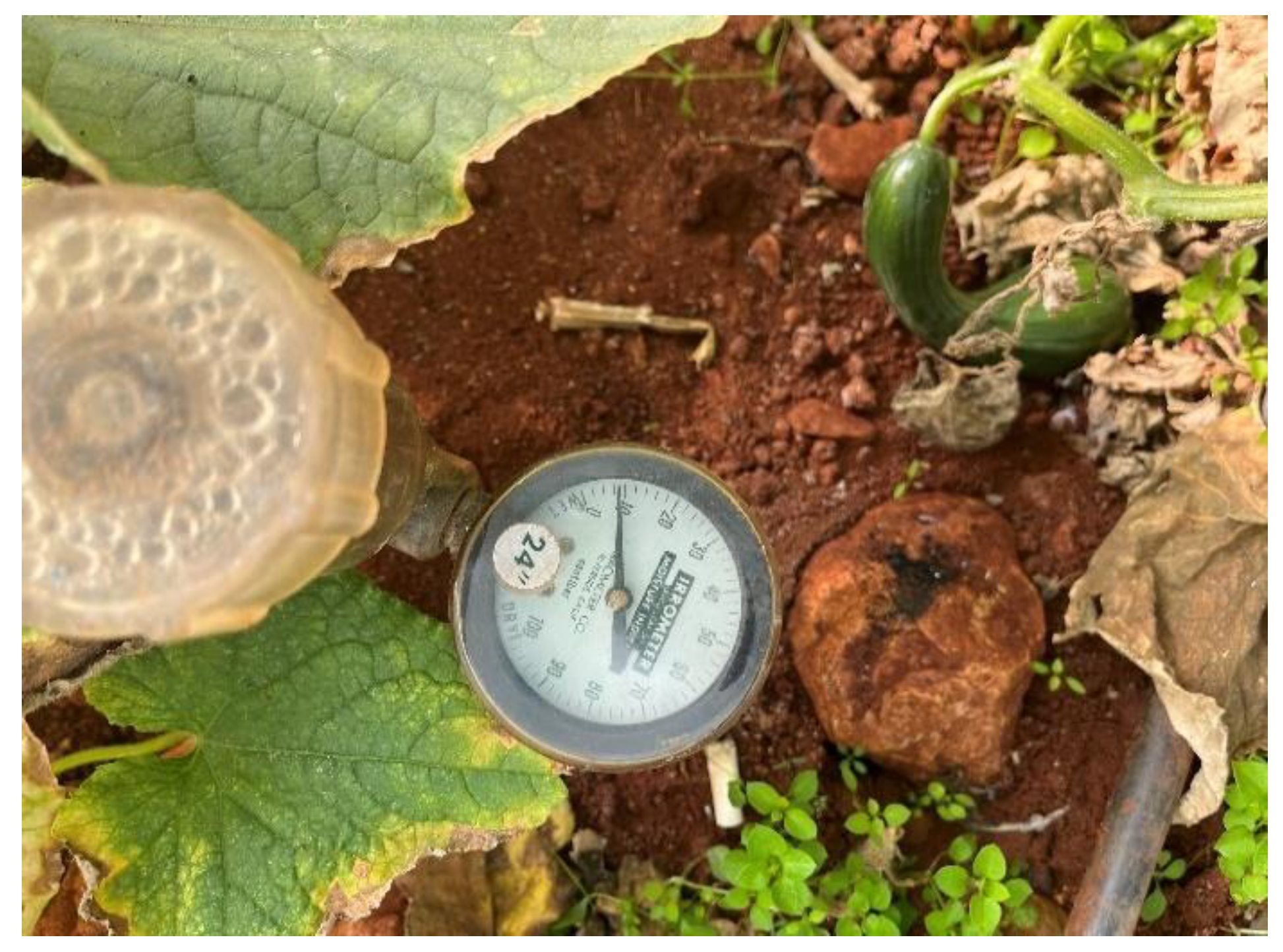
Figure 9.
Water meter to control water application, a practice often ignored by local farmers.
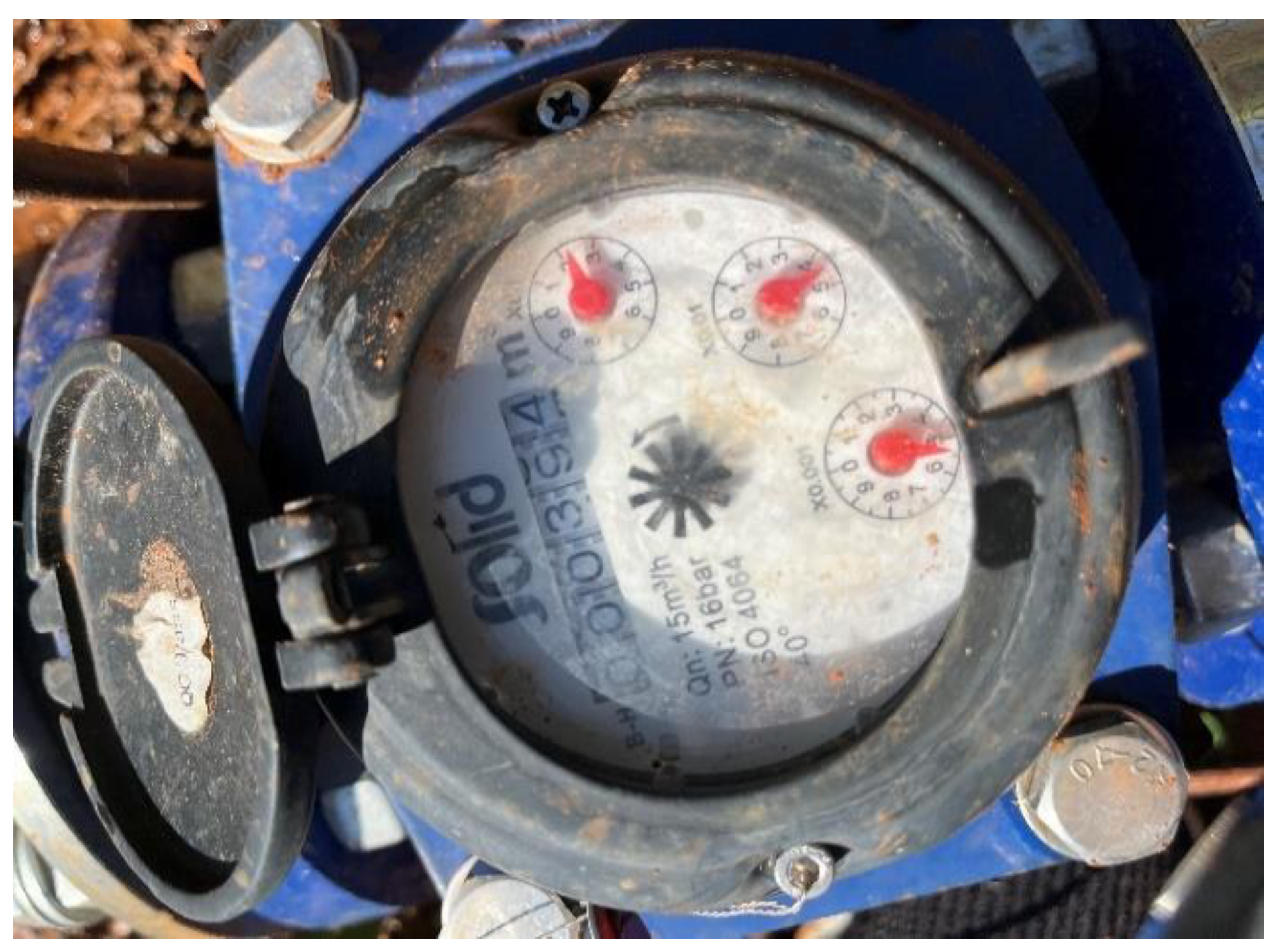
Figure 10.
Protected cucumber in Serein.
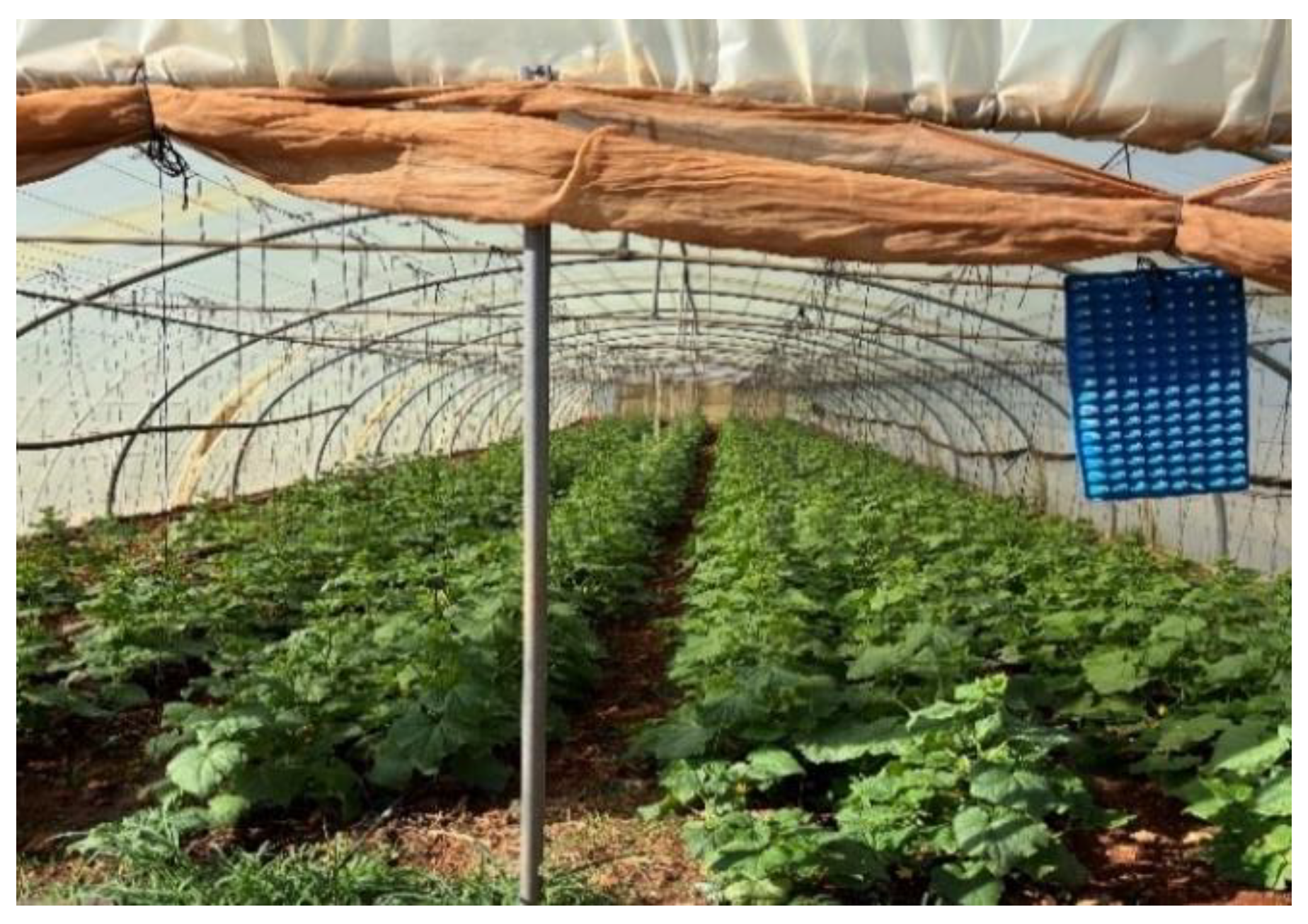
Figure 11.
Protected cucumber in Sultan Yacoub.
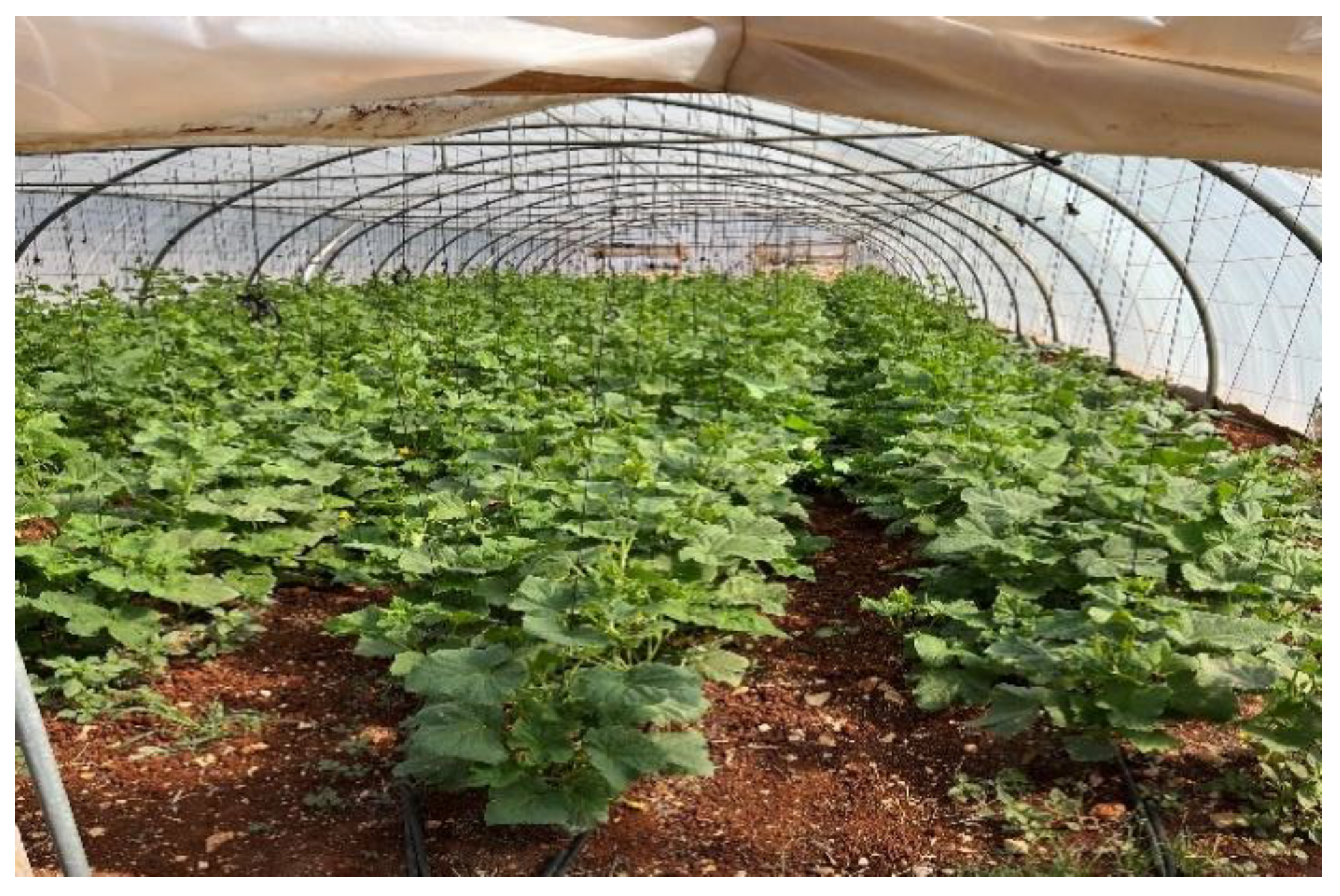
Figure 12.
Science based water application by SEALACOM project to protected cucumber during the short fall 2023 season in Serein.
Figure 12.
Science based water application by SEALACOM project to protected cucumber during the short fall 2023 season in Serein.
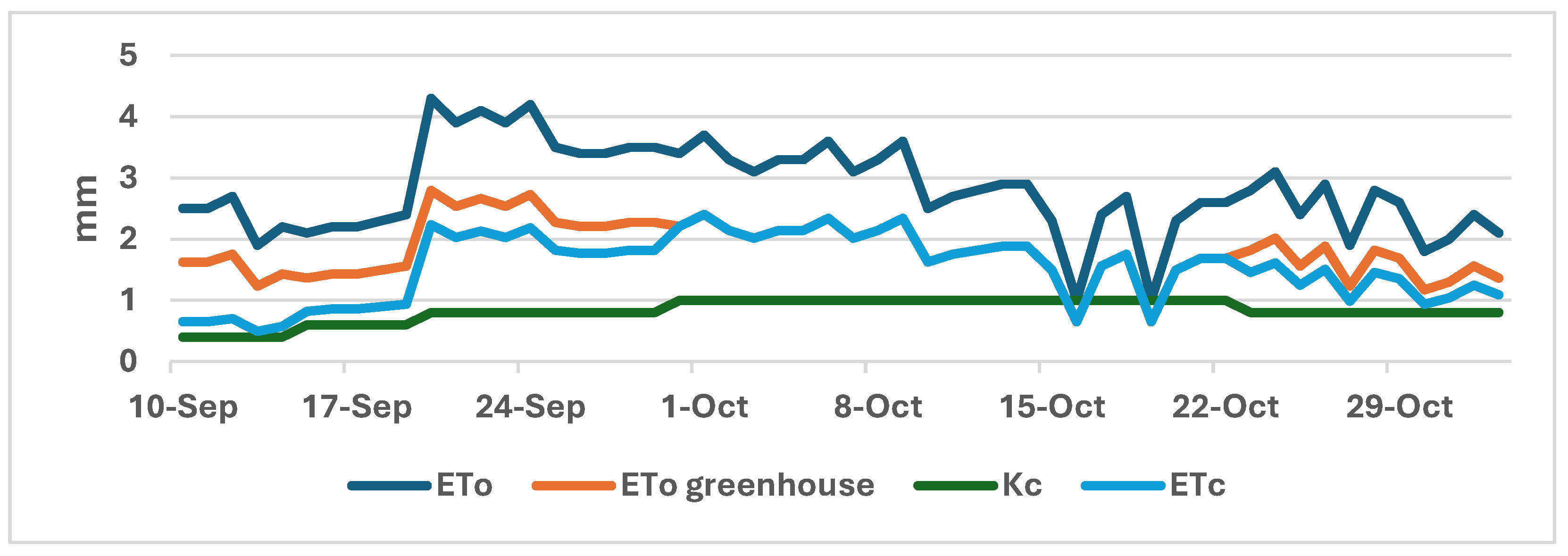
Figure 13.
Water application saving potential in protected cucumber in Bekaa, Lebanon.
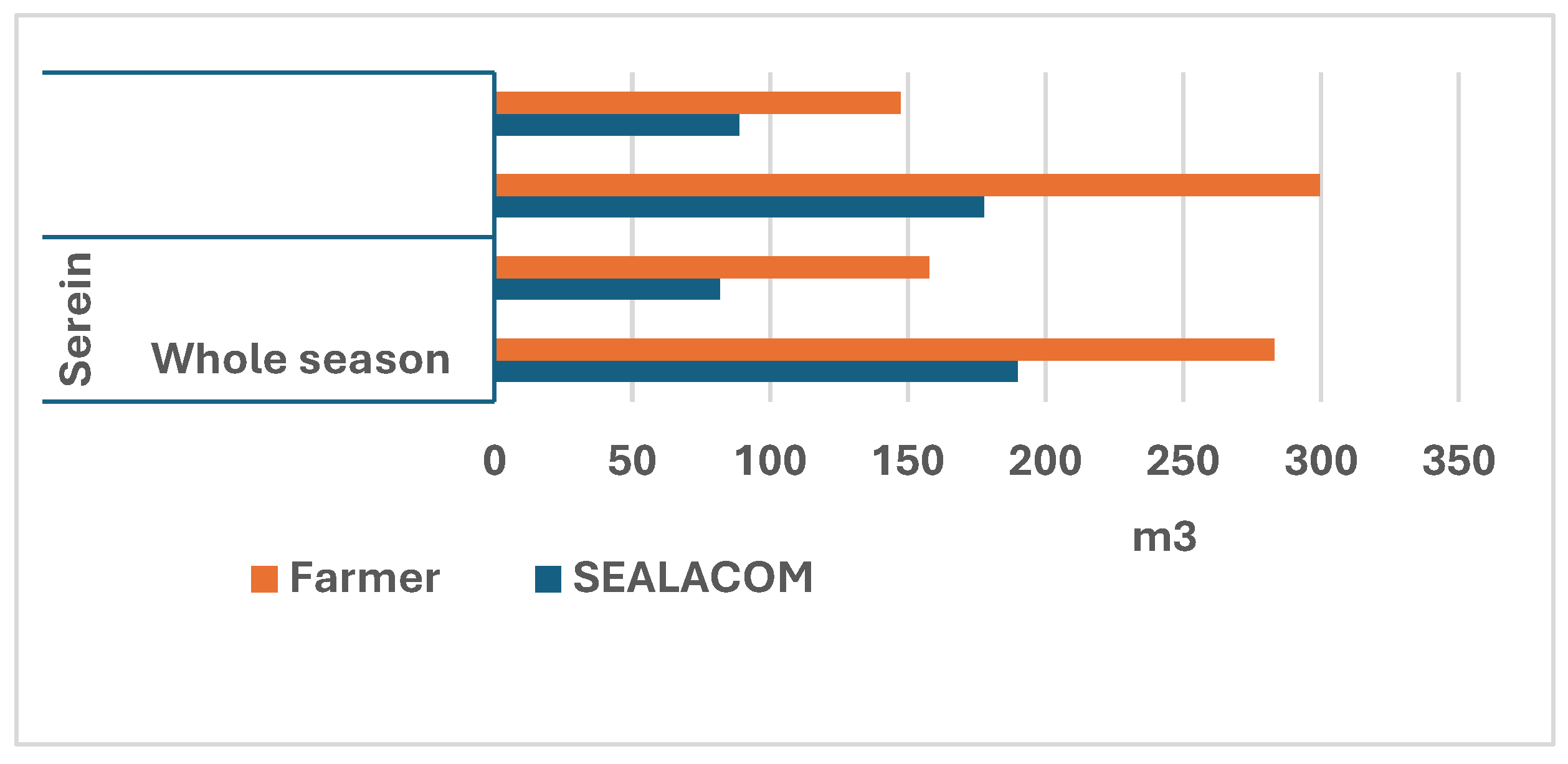
Figure 14.
Measured soil head potential at surface soil layer in late fall protected cucumber in Central and West Bekaa plain of Lebanon showing water stressed plant in farming practice during the early stage of.
Figure 14.
Measured soil head potential at surface soil layer in late fall protected cucumber in Central and West Bekaa plain of Lebanon showing water stressed plant in farming practice during the early stage of.

Figure 15.
Measured soil head potential in subsoil in late fall protected cucumber in Central and West Bekaa plain of Lebanon.
Figure 15.
Measured soil head potential in subsoil in late fall protected cucumber in Central and West Bekaa plain of Lebanon.
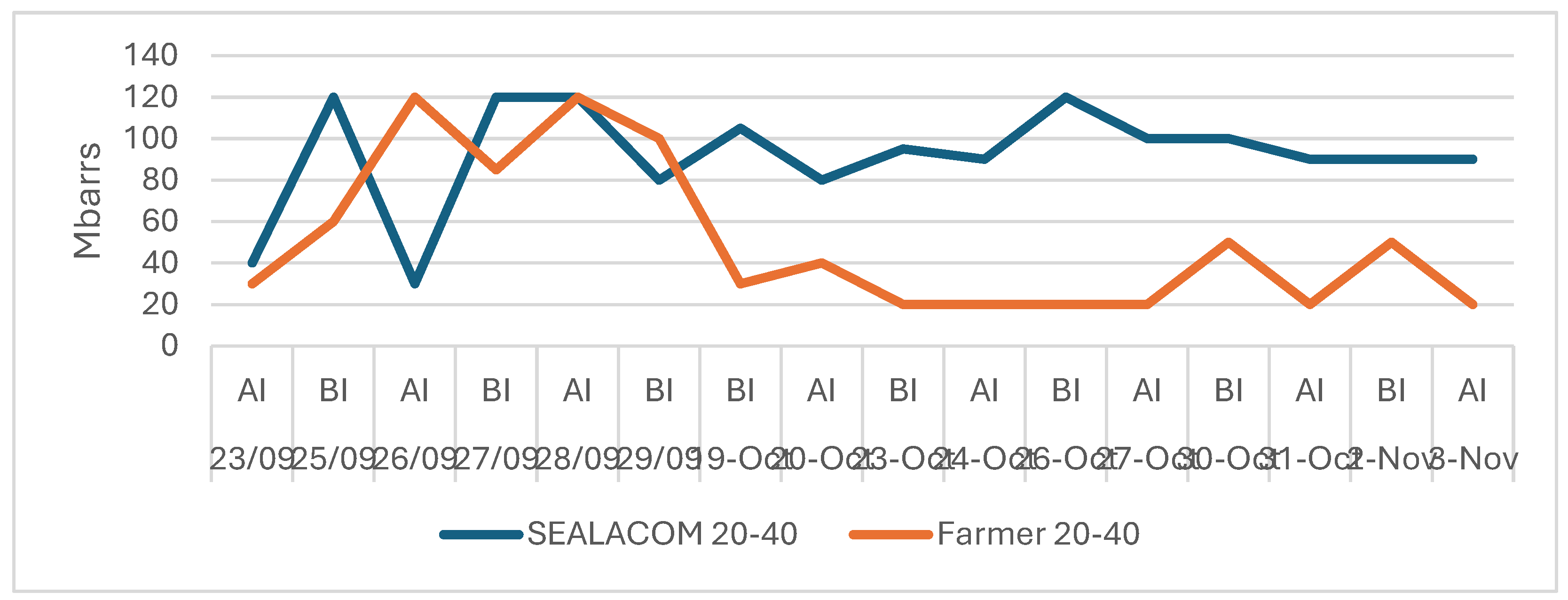
Figure 16.
Comparative cumulative yield of protected cucumber in Serein following farmer’s practice (F-G4, F-G5 and F-G6) and SEALACOM approach (S-G1, S-G2 and S-G3).
Figure 16.
Comparative cumulative yield of protected cucumber in Serein following farmer’s practice (F-G4, F-G5 and F-G6) and SEALACOM approach (S-G1, S-G2 and S-G3).
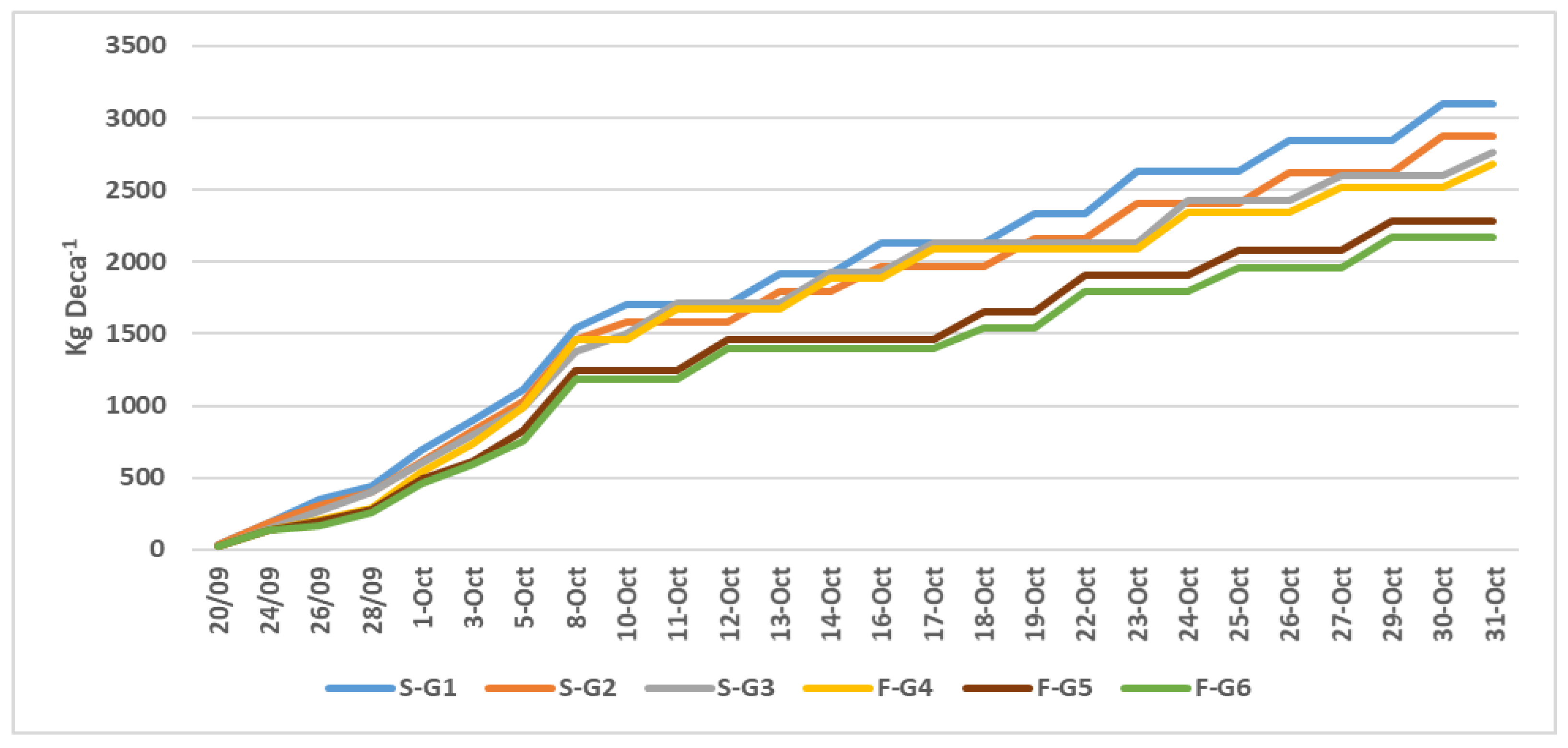
Figure 17.
Comparative yield of protected cucumber in Sultan Yacoub following the farmer’s practice (F) and SEALACOM approach (S).
Figure 17.
Comparative yield of protected cucumber in Sultan Yacoub following the farmer’s practice (F) and SEALACOM approach (S).
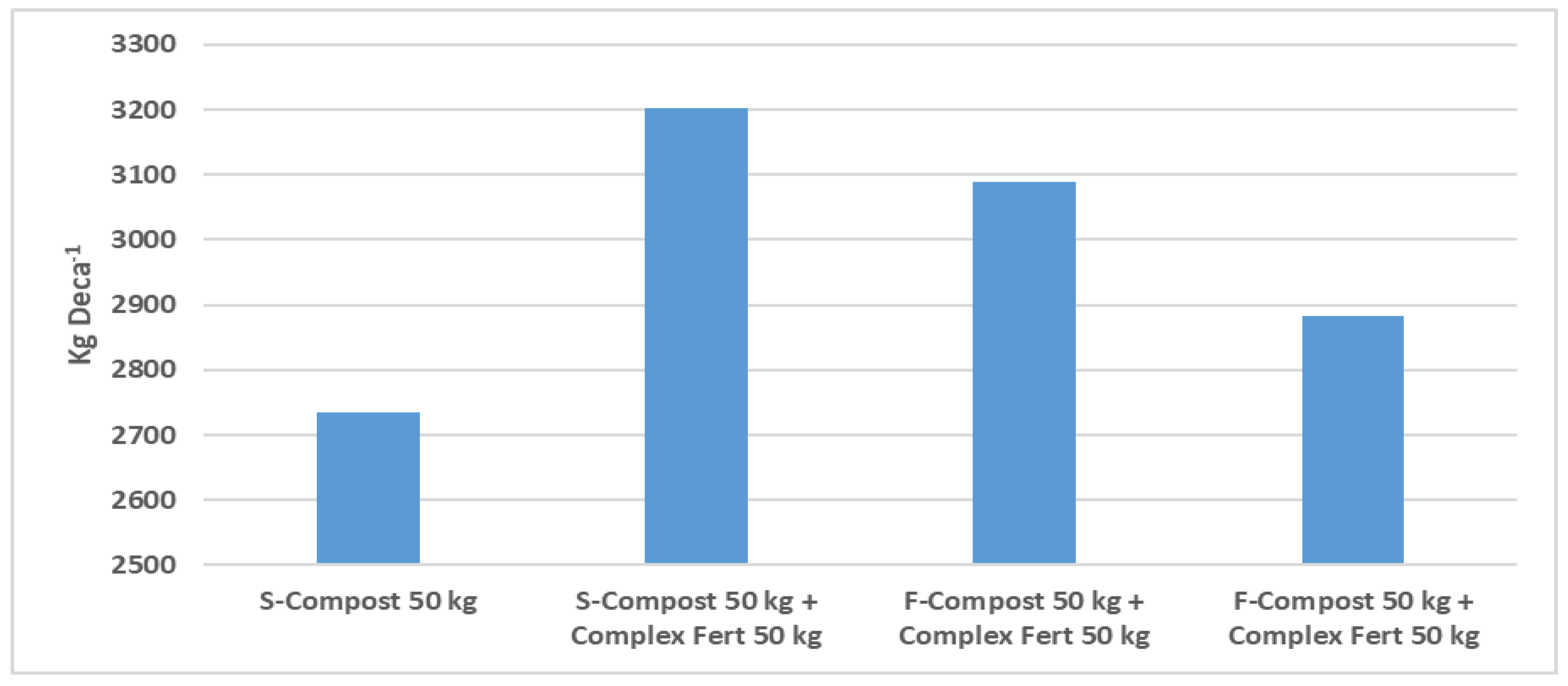
Table 1.
Physico-chemical characteristics of the soils of the two DSs before the experiment.
| Soil type | Depth, cm |
Total Sand | Silt | Clay | CaCO3 Total | CaCO3 active | O.M. | EC | pH H2O | Available Nutrients, ppm | ||
|---|---|---|---|---|---|---|---|---|---|---|---|---|
| % | ds m-1 | N | P2O5 | K2O | ||||||||
| Eutric Regosols DS1-Serein | 0-20 | 36 | 18 | 46 | 5.6 | 1.9 | 2.74 | 0.49 | 7.6 | 23.8 | 354 | 280 |
| 20-40 | 30 | 20 | 50 | 3.8 | 1.3 | 1.55 | 0.33 | 7.4 | 23.1 | 305 | 268 | |
| Eutric Cambisols DS2-Sultan Yacoub | 0-20 | 26 | 12 | 62 | 5.8 | 1.9 | 1.25 | 0.34 | 7.7 | 32.2 | 206 | 578 |
| 20-40 | 24 | 16 | 60 | 5.8 | 1.9 | 1.31 | 0.3 | 7.8 | 27 | 185 | 627 | |
Table 2.
Amount of water application under protected cucumber in late summer 2023 by the SEALACOM project and farmers.
Table 2.
Amount of water application under protected cucumber in late summer 2023 by the SEALACOM project and farmers.
| Location | Water application | SEALACOM | Farmer | Difference (Farmers -SEALACOM) |
Potential water saving from protected greenhouses in one cucumber season, m3 | |
|---|---|---|---|---|---|---|
| (mm) | SEALACOM DS (120 ha) | Country level (1560 ha) |
||||
| Serein | Whole season | 190.0 | 283.0 | 93 | 111,600 | 1,450,800 |
| Sultan Yacoub | 177.70 | 299.67 | 121.97 | 146,335 | 1,902,732 | |
| Serein | Productive period | 81.75 | 157.83 | 76.08 | 91,278 | 1,186,848 |
| Sultan Yacoub | 88.83 | 147.3 | 58.47 | 70150 | 912,132 | |
Table 3.
Fertilization of protected fall cucumber following the traditional practice (Farmer) or advanced methods (SEALACOM) in Central Bekaa.
Table 3.
Fertilization of protected fall cucumber following the traditional practice (Farmer) or advanced methods (SEALACOM) in Central Bekaa.
| Location | Nutrient | Pure Element (Kg Deca-1) | Fertilizer Equivalent (Kg Deca-1) | ||||||
|---|---|---|---|---|---|---|---|---|---|
| N | P2O5 | K2O | MgO | Amm. Sulfate | MAP | Pot. Sulfate | Mg Sulfate | ||
| Serein | Farmer | 27.52 | 11.39 | 6.05 | 2.01 | 131.02 | 18.66 | 12.11 | 13.39 |
| SEALACOM | 10.14 | 2.41 | 12.54 | 0.65 | 48.27 | 3.96 | 25.08 | 4.36 | |
| Sultan Yacoub | Farmer | 26.86 | 73.59 | 9.80 | 0.00 | 127.92 | 120.65 | 19.61 | 0.00 |
| SEALACOM | 11.40 | 2.51 | 13.79 | 1.62 | 54.30 | 4.12 | 27.58 | 10.77 | |
Table 4.
Cucumber yield and confidence interval obtained from traditional and improved cultivation of protected cucumber in Bekaa Plain, Lebanon.
Table 4.
Cucumber yield and confidence interval obtained from traditional and improved cultivation of protected cucumber in Bekaa Plain, Lebanon.
| Treatment | Mean Yield (kg/deca) | Confidence Interval (ConI) | Range [Mean ± ConI] |
|---|---|---|---|
| Improved practice | 2911.6 | 191.2 | 2720.4 - |
| Farmers practice | 2379.5 | 305.0 | + 2684.5 |
Table 5.
Comparative water use efficiency in farmer’s practice versus modern tools of irrigation and fertilization (SEALACOM) for late fall protected cucumber in Central Bekaa, Lebanon.
Table 5.
Comparative water use efficiency in farmer’s practice versus modern tools of irrigation and fertilization (SEALACOM) for late fall protected cucumber in Central Bekaa, Lebanon.
| Practice | Serein | Sultan Yacoub | ||||||
|---|---|---|---|---|---|---|---|---|
| Total applied Water, mm |
Water application during the production stage, mm | Application water use efficiency, Kg/mm | Agronomic water use efficiency, Kg/mm | Total applied Water, mm |
Water application during the production stage, mm | Application water use efficiency, Kg/mm | Agronomic water use efficiency, Kg/mm | |
| Farmer | 283 | 190.3 | 8.4 | 12.5 | 299.7 | 147.3 | 9.96 | 20.27 |
| SEALACOM | 190.3 | 82.2 | 15.3 | 35.4 | 177.7 | 88.83 | 16.7 | 33.42 |
Table 6.
Statistical analysis of water productivity in improved fertigation versus farmer’s practices.
Table 6.
Statistical analysis of water productivity in improved fertigation versus farmer’s practices.
| Treatment | Site | Replicate | Applied water m3/Deca | Cucumber yield Kg/Deca | Water productivity Kg/m3 | Mean | Confidence Interval | Interval | |
| minimum | maximum | ||||||||
| Improved | Serein | 1.1 | 190.26 | 3096.39 | 16.27 | 15.30 | 1.01 | 14.29 | 16.32 |
| 1.2 | 190.26 | 2873.49 | 15.10 | ||||||
| 1.3 | 190.26 | 2765.06 | 14.53 | ||||||
| Sultan Yacoub | 1.4 | 177.70 | 2735.29 | 15.39 | 16.71 | 2.58 | 14.13 | 19.29 | |
| 1.5 | 177.70 | 3202.61 | 18.02 | ||||||
| Mean improved treatment | 15.86 | 1.19 | 14.67 | ||||||
| Farmers | Serein | 2.1 | 283.06 | 2683.73 | 9.48 | 8.41 | 1.08 | 7.33 | 9.49 |
| 2.2 | 283.06 | 2285.24 | 8.07 | ||||||
| 2.3 | 283.06 | 2169.58 | 7.66 | ||||||
| Sultan Yacoub | 2.4 | 299.67 | 3088.24 | 10.31 | 9.96 | 0.67 | 9.29 | 10.63 | |
| 2.5 | 299.67 | 2882.35 | 9.62 | ||||||
| Mean farmers treatment | 9.03 | 0.97 | 10.00 | ||||||
Table 7.
Nitrogen use efficiency in late fall protected cucumber grown with traditional (Farmer) and advanced methods (SEALACOM) of water and fertilizer application.
Table 7.
Nitrogen use efficiency in late fall protected cucumber grown with traditional (Farmer) and advanced methods (SEALACOM) of water and fertilizer application.
| Practice | Average Yield, Kg Deca-1 | Applied Nitrogen, Kg Deca-1 | N use efficiency, Kg cucumber/Kg Nitrogen | |||
|---|---|---|---|---|---|---|
| Serein | Sultan Yacoub | Serein | Sultan Yacoub | Serein | Sultan Yacoub | |
| Farmer | 2379.5 | 2969 | 27.52 | 26.86 | 86.5 | 111.14 |
| SEALACOM | 2911.6 | 2985.3 | 10.14 | 11.4 | 287.1 | 255.4 |
Table 8.
Post experiments physico-Chemical properties of the soil under protected Cucumber in Serein.
Table 8.
Post experiments physico-Chemical properties of the soil under protected Cucumber in Serein.
| Demo Site | Depth, cm |
SEALACOM Practice | Farmer's Practice | ||||||
|---|---|---|---|---|---|---|---|---|---|
| EC dS/m |
pH H2O | Available Nutrients, ppm | EC | pH H2O | Available Nutrients, ppm | ||||
| P2O5 | K2O | dS/m | P2O5 | K2O | |||||
| Serein | 0-20 | 0.64 | 7.6 | 233 | 307 | 0.39 | 7.6 | 232 | 275 |
| 20-40 | 0.63 | 7.6 | 236 | 283 | 0.38 | 7.6 | 239 | 253 | |
| Sultan Yacoub | 0-20 | 0.59 | 7.4 | 174 | 830 | 0.58 | 7.6 | 137 | 831 |
| 20-40 | 0.51 | 7.4 | 200 | 818 | 0.34 | 7.7 | 101 | 707 | |
Disclaimer/Publisher’s Note: The statements, opinions and data contained in all publications are solely those of the individual author(s) and contributor(s) and not of MDPI and/or the editor(s). MDPI and/or the editor(s) disclaim responsibility for any injury to people or property resulting from any ideas, methods, instructions or products referred to in the content. |
© 2024 by the authors. Licensee MDPI, Basel, Switzerland. This article is an open access article distributed under the terms and conditions of the Creative Commons Attribution (CC BY) license (http://creativecommons.org/licenses/by/4.0/).
Copyright: This open access article is published under a Creative Commons CC BY 4.0 license, which permit the free download, distribution, and reuse, provided that the author and preprint are cited in any reuse.
MDPI Initiatives
Important Links
© 2024 MDPI (Basel, Switzerland) unless otherwise stated






